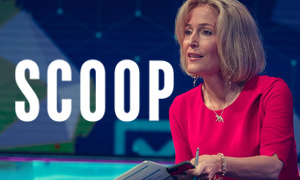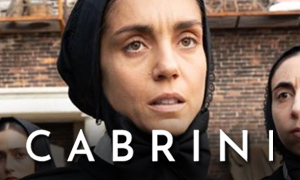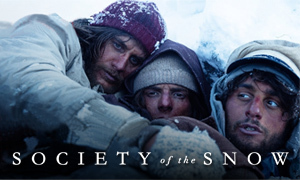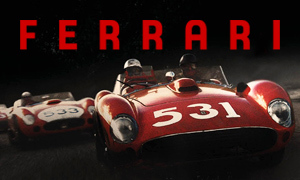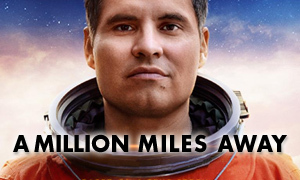A Million Miles Away: History vs. Hollywood
Michael Peña
Born: January 13, 1976
Birthplace:
Chicago, Illinois, USA
José Hernández
Born: August 7, 1962
Birthplace: French Camp, California, USA
Rosa Salazar
Born: July 16, 1985
Birthplace:
Washington D.C., USA
Adela Hernández
Bio: José's Wife
Julio Cesar Cedillo
Born: January 1, 1970
Birthplace:
Durango, Mexico
Salvador Hernández
Birthplace: Mexico
Bio: José's Dad
Veronica Falcón
Born: August 8, 1966
Birthplace:
Mexico City, Mexico
Julia Hernandez
Birthplace: Mexico
Bio: José's Mom
Did José Hernández come from a family of migrant farmworkers?
Yes. "I started off working on the land, a land that wasn't mine." José Hernández told ABC News. "I worked for other farmers, picking just about any fruit and vegetable that grows here in the Valley. You name it, they grow it here, we picked it, including grapes." José's family also picked strawberries, cherries, onions and cucumbers, to name a few. In researching the A Million Miles Away true story, we learned that each year, his parents would bring the family from Mexico to California to pick, spending nine months in the fields before returning to Michoacán, their home state in Central Mexico. "It's the only life we knew, and to me, it was normal. That's where I think my work ethic came from." José is the youngest of four children and has two brothers and a sister.
"Some of us were lucky enough to be born [in the U.S.]. Some of us were born in Mexico," José said of himself and his siblings. "I was born during the harvest months, so I was born here in Stockton, California. ... As I grew up, my parents would take us every Saturday and Sunday, if they were working in the fields, we would be working with them. While lots of kids loved summer vacation, us Hernández kids hated it because that meant we would be seven days a week working in the fields." -Valley PBS
Did José Hernández want to be an astronaut from a young age?
Yes. As a boy, José excelled in math and science, and by age 10, he knew that he wanted to be an astronaut. Our A Million Miles Away fact-check confirms that he told his parents about his dream after watching the Apollo 17 moon landing on TV in 1972. "I remember being mesmerized by the images of the astronaut Gene Cernan walking on the moon," José recalled. "I would go outside, see the moon, come back in, watch, do that several times. I would say, 'My God, we have humans up there, a quarter million miles away.' I remember that day. I said, 'That's what I wanna be. I wanna be an astronaut.' And I shared that dream with my parents." To learn more about José's childhood, read his biography Reaching for the Stars on which the movie is based. -TEDx Talks
Did José Hernández's father support his dream of becoming an astronaut?
Yes. "I think what he saw was the determination of a 10-year-old boy," José told ABC News. He said his father's belief in him helped shape the trajectory of his life. "He validated the dream. He empowered me to believe I can do it." Upon telling his father that he wanted to be an astronaut, his father replied, "I think you can do it."
While exploring the A Million Miles Away fact vs. fiction, we discovered that José also credits his second-grade teacher, Ms. Young, with changing the course of his life dramatically. As a child, his parents told him to get his three months' worth of homework because the family was hitting the road again for work. This is when José's teacher showed up at their house and told his parents that education needs to be a priority. They need to consider the future for their children.
"She explained it in very simple terms," said José of his teacher. "She described us kids as trees. She said, 'You keep transplanting a tree, it's gonna grow weak. You have to stay in one place so that the trees grow deep roots, branches grow big, and you have big trees.' And my parents took that to heed."
That's when everything changed for José and his siblings. His parents decided to remain in Stockton, California and no longer pull the kids out of school for such long periods. "I believe that's when our education got traction," said José, "and we started doing even better in school" (Valley PBS). Ms. Young also gave José a book about space that he read over and over and still has today.
Was José Hernández an engineer prior to becoming an astronaut?
After graduating high school in 1980, Hernández earned a degree in electrical engineering from the University of the Pacific in 1984. He completed his master's degree at the University of California, Santa Barbara two years later in electrical and computer engineering and began working at the Lawrence Livermore National Laboratory where he was a key figure in the invention of the mobile mammogram machine. While working there, he began applying to NASA.
Was José Hernández rejected 11 times when applying for the Astronaut Candidate Program?
Yes. The A Million Miles Away true story confirms that José Hernández was rejected by NASA eleven times. It took him 12 years before he was finally accepted into the program in 2004. Hernández said that he made it to the final one hundred candidates three times from a pool of thousands of applicants. "You could almost taste it," he told ABC News.
During an interview on the Jocko Podcast, he said that NASA did offer him an engineering job during that time, but he declined the offer out of devotion to his current employer, the federally funded Lawrence Livermore Lab, which had given him a new station assignment in Washington, D.C. and spent "about $25,000" moving his family. "I was working at DOE headquarters in downtown Washington, D.C.," said Hernández. "I had a commitment for two years, and I couldn't in good conscience, after being there a couple months, say, 'Well, you know, I changed my mind. Thanks for spending that $25K. I'm going to Houston now' ... It wasn't the right thing to do. I had made a commitment and I wanted to fulfill it."
Hernández figured he wouldn't hear from NASA again, but to his surprise, he eventually got another job offer to work in Houston as an engineer. This was after he completed his D.C. assignment with Livermore Labs. His wife Adela encouraged him to take the NASA job if it meant he'd have a better chance of becoming an astronaut. He worked for NASA for about four years before he was finally selected for the astronaut training program. During that time, his wife Adela ran a Mexican restaurant, the Tierra Luna Grill, near the Johnson Space Center. He credits his time working on the investigation into the 2003 Space Shuttle Columbia disaster as helping him gain credibility at NASA. He was one of the spokespeople who explained the science behind why the shuttle disintegrated during re-entry.
"I got a lot of face time with a lot of people at NASA," he told Jocko Willink of his time investigating the cause of the Columbia disaster, "and they started looking at me and trusting me. ... Shortly thereafter, the following year, they have a selection of astronauts, and I'm again one of the finalists, and this time, when I sit down across [from] the eighteen people that are there, you know, I know more than half of them through this accident investigation board. ... So, it's kinda like, I'd come home to family now. Before, it was a complete set of strangers, and now, everybody knew me, I knew them."
"Don't be so quick to give up on your dreams if you've failed once or twice," Hernández remarked to ABC News. "Sure, failure doesn't feel good. Sure, rejection doesn't feel good, but if you prepare yourself, you can come back stronger, and eventually you'll get there." Hernández received his astronaut wings in 2006.
Did José Hernández have young children at the time he became an astronaut?
Yes. Similar to what's seen in the José Hernández movie, a fact-check corroborates that he and his wife Adela had five children at the time, having welcomed their fifth child into the world the year prior, on January 21, 2003.
Did the real José Hernández go into space?
Yes. In researching how accurate is A Million Miles Away, we learned that on August 28, 2009, Hernández blasted off aboard Space Shuttle Discovery from Cape Canaveral, Florida as the Flight Engineer on the STS-128 Mission, a nearly 14-day mission to the International Space Station (watch the launch). His parents, wife, five children, siblings, and extended family were on hand to watch the launch. Unlike the movie, the real-life launch happened in the dark just before midnight. It was one of the final missions that carried a payload to complete the construction of the International Space Station. The payload consisted of seven tons of equipment to install inside and outside of the space station. As emphasized in the José Hernández movie, he became the first first-generation Mexican-American astronaut. He also notably sent the first Tweet from space in Spanish, wishing the U.S., Mexico, and Latin American countries good luck in the upcoming qualifying rounds for the World Cup. -ABC News
"I just couldn't believe that, here's this kid working up as a migrant farmworker, who was able to pull himself up by the bootstraps, get a good education, and be able to become an astronaut," said Hernández. "How cool is the fact that NASA allows you to do this? How cool is the fact that this country allows you to do this? And it's certainly living true example of the American dream." -Valley PBS
Did bad weather force the Space Shuttle Discovery to land in California instead of Florida?
Yes. In exploring the A Million Miles Away true story, we discovered that bad weather in Florida indeed forced the landing site to be changed to California. At the end of the STS-128 mission, which lasted approximately 13 days, 20 hours and 55 minutes, Space Shuttle Discovery landed at Edwards Air Force base in California on September 12, 2009 (watch the landing). "I always call it poetic justice," says Hernández. "Why? Because it's about 80 miles from where I used to pick strawberries." -ABC News
What became of Astronaut José Hernández after leaving NASA?
After retiring from NASA in 2011, the husband and father of five headed back to Stockton, California, where he ran a consulting business and devoted his spare time to the community. He established the Reaching for the Stars Foundation, which offers no-cost STEM-based summer programs for kids to help them achieve their dreams.
Hernández entered the political arena at the urging of President Obama, who ironically had canceled NASA's Constellation program in 2011 and defunded NASA's priority of sending astronauts beyond low Earth orbit. Hernández decided to run for Congress in 2011 as a Democrat in California's 10th congressional district, competing for a seat in the House of Representatives. He won his party's nomination but lost the 2012 general election to Jeff Denham, the Republican incumbent.
Hernández purchased his own 20-acre plot of land near Lodi, California on which he operates a vineyard. It is not far from where his family had labored as migrant workers for years. "It's great because it's kind of like coming full circle," Hernández told PBS. "As a kid, I used to work picking grapes, and it's kind of like pretty neat that now I own the grapes." In 2021, José Hernández bottled the first vintage of his own brand, Tierra Luna wine, which translates to "Earth Moon" wine. -ABC News
